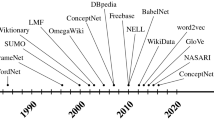Abstract
This paper describes a new framework consisting of two mechanisms: one for building a rich vocabulary based on a lexical semantics, and the other for evaluating queries using such a vocabulary. A vocabulary built by the former mechanism has the following two features: (a) richness because of its expandability, and (b) the lexical-semantic definability of its words. Query expressions using such a rich vocabulary satisfy the following two properties: (c) no need to use nested queries, and (d) no need to use variables. In our framework, each vocabulary consists of basic words and derived words. A derived word can be defined as a character string label given to an expression that combines already defined words with operators. When someone defines a large vocabulary with all of its basic words being mapped to an ontology of the underlying Semantic Web, users can query this Semantic Web using this vocabulary.
Access this chapter
Tax calculation will be finalised at checkout
Purchases are for personal use only
Preview
Unable to display preview. Download preview PDF.
Similar content being viewed by others
References
W3C: RDF Vocabulary Description Language 1.0: RDF Schema, http://www.w3.org/TR/rdf-schema/
W3C: OWL Web Ontology Language Overview, http://www.w3.org/TR/owl-features/
W3C: SWRL: A Semantic Web Rule Language Combining OWL and RuleML, http://www.w3.org/Submission/SWRL/
W3C: SPARQL Query Language for RDF, http://www.w3.org/TR/rdf-sparql-query/
Dublin Core Metadata Initiative: DCMI Metadata Terms, http://dublincore.org/documents/dcmi-terms/
W3C: FOAF Vocabulary Specification 0.97, http://xmlns.com/foaf/spec/
Auer, S., Bizer, C., Kobilarov, G., Lehmann, J., Cyganiak, R., Ives, Z.: DBpedia: A Nucleus for a Web of Open Data. In: Aberer, K., Choi, K.-S., Noy, N., Allemang, D., Lee, K.-I., Nixon, L.J.B., Golbeck, J., Mika, P., Maynard, D., Mizoguchi, R., Schreiber, G., Cudré-Mauroux, P. (eds.) ASWC 2007 and ISWC 2007. LNCS, vol. 4825, pp. 722–735. Springer, Heidelberg (2007)
Tanaka, Y.: Vocabulary Building for Database Queries. In: Goto, E., Nakajima, R., Yonezawa, A., Nakata, I., Furukawa, K. (eds.) RIMS 1982. LNCS, vol. 147, pp. 215–232. Springer, Heidelberg (1983)
Goto, F., Tanaka, Y.: Vocalog: An Extended Logic Programming Language Capable of Generic Concept-Description Using a Vocabulary. Transactions of Information Processing Society of Japan 33(4), 512–520 (1992)
Funk, A., Tablan, V., Bontcheva, K., Cunningham, H., Davis, B., Handschuh, S.: CLOnE: Controlled Language for Ontology Editing. In: Aberer, K., Choi, K.-S., Noy, N., Allemang, D., Lee, K.-I., Nixon, L.J.B., Golbeck, J., Mika, P., Maynard, D., Mizoguchi, R., Schreiber, G., Cudré-Mauroux, P. (eds.) ASWC 2007 and ISWC 2007. LNCS, vol. 4825, pp. 142–155. Springer, Heidelberg (2007)
Bernstein, A., Kaufmann, E.: GINO - A Guided Input Natural Language Ontology Editor. In: Cruz, I., Decker, S., Allemang, D., Preist, C., Schwabe, D., Mika, P., Uschold, M., Aroyo, L.M. (eds.) ISWC 2006. LNCS, vol. 4273, pp. 144–157. Springer, Heidelberg (2006)
Bernstein, A., Kaufmann, E., Göhring, A., Kiefer, C.: Querying Ontologies: A Controlled English Interface for End-Users. In: Gil, Y., Motta, E., Benjamins, V.R., Musen, M.A. (eds.) ISWC 2005. LNCS, vol. 3729, pp. 112–126. Springer, Heidelberg (2005)
Cimiano, P., Haase, P., Heizmann, J.: Porting natural language interfaces between domains: an experimental user study with the ORAKEL system. In: Proc. of the 12th Int. Conf. on Intelligent User Interfaces, pp. 180–189 (2007)
Author information
Authors and Affiliations
Editor information
Editors and Affiliations
Rights and permissions
Copyright information
© 2010 Springer-Verlag Berlin Heidelberg
About this paper
Cite this paper
Asano, Y., Tanaka, Y. (2010). A Vocabulary Building Mechanism Based on Lexical Semantics for Querying the Semantic Web. In: Setchi, R., Jordanov, I., Howlett, R.J., Jain, L.C. (eds) Knowledge-Based and Intelligent Information and Engineering Systems. KES 2010. Lecture Notes in Computer Science(), vol 6276. Springer, Berlin, Heidelberg. https://doi.org/10.1007/978-3-642-15387-7_68
Download citation
DOI: https://doi.org/10.1007/978-3-642-15387-7_68
Publisher Name: Springer, Berlin, Heidelberg
Print ISBN: 978-3-642-15386-0
Online ISBN: 978-3-642-15387-7
eBook Packages: Computer ScienceComputer Science (R0)




